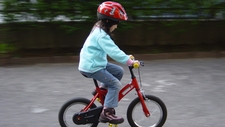Importance of Safe Practices

TEKS Objective
The student will recognize the importance of safe practices to keep self and others safe and healthy.
Essential Understanding
The student conducts classroom and outdoor investigations following home and school safety procedures and uses environmentally appropriate and responsible practices.
Science Background
Science Safety in Elementary Schools: BioEd Online (video) - Online presentation covering classroom safety practices, particularly during students’ science investigations. Includes information about key safety equipment and strategies for setting up a safety object wall.
Science Safety in Elementary Schools
BioEd Online, www.bioedonline.org
Science and Safety, It’s Elementary: Council of State Science Supervisors (PDF) - A handy, concise reference for elementary teachers of science, with basic guidelines for safe practices and facilities, and answers to commonly asked questions about science teaching and safety.
Science and Safety, It’s Elementary
Council of State Science Supervisors, www.csss-science.org
Safety Equipment and Supplies: Charles A. Dana Center (PDF) - Detailed information about a wide variety of safety equipment that may be needed in a science classroom.
Safety Equipment and Supplies
Charles A. Dana Center, www.utdanacenter.org
Signature Lesson
Healthy Kids, Keeping Safe: Oregon Department of Education (PDF) - Students learn what germs are, how we can reduce the transmission of germs, how our bodies are protected against germs, and safe practices that promote good health for ourselves and others. (See grade 1, lesson 1, page 43-48).
Healthy Kids, Keeping Safe
Oregon Department of Education, www.ode.state.or.us
Safety, Injury, and Violence Prevention: Wichita State University (website) - Students discuss and learn the importance of safety rules for home, school, and beyond, and then draw or write about what they have learned.
Healthy Kids, Keeping Safe
Oregon Department of Education, education.wichita.edu
- Supporting Lessons
- Extensions
- Assessment Ideas
- Literature Connections
- Related
TEKS - Additional Resources
Supporting Lessons
Germs Can Make You Sick: Science NetLinks (website) - Students learn how germs are spread, what diseases germs can cause, and how hand washing can help prevent the spread of germs.
Germs Can Make You Sick
Science NetLinks, www.sciencenetlinks.com
Clean Gene’s Ultimate Cough Cover-Up: Gojo Industries (PDF) - Learn why it is importance to cover your mouth when you cough.
Clean Gene’s Ultimate Cough Cover-Up
Gojo Industries, www.gojo.com
Elaboration Lessons and Extensions
Clean Gene’s Germ-fighters Hit Parade: Gojo Industries (PDF) - A familiar tune with new words helps students learn how to wash their hands thoroughly to clean them of germs.
Clean Gene’s Germ-fighters Hit Parade
Gojo Industries, www.gojo.com
Assessment Ideas
Ask students to list five steps they can take to make the classroom a healthier, safer place for themselves and others.
Literature Connections
Healthy Me: Fun Ways to Develop Good Health and Safety Habits. O’Brien-Palmer, Michelle (ISBN-13: 978-1556523595)
First Aid for You. Weber, Rebecca (ISBN-13: 978-0756509262)
Safety. Gogerly, Liz (ISBN-13: 978-0778741206)
Additional Resources
Healthy Kids, Keeping Safe: Oregon Department of Education (PDF) - Extensive collection of activities for elementary students, focused on safety and disease prevention practices.
Healthy Kids, Keeping Safe
Oregon Department of Education, www.ode.state.or.us
Skin Health and Hygiene Solutions: Gojo Industries (PDF) - Lesson plans that teach proper hand hygiene and its importance in keeping students safe and healthy.
Skin Health and Hygiene Solutions
Gojo Industries, www.gojo.com
Preventing Injuries: Safe Kids USA (website) - A wealth of safety information for students, covering everything from basic safety practices and facts sheets to activities you can adapt for any grade level.
TEKS Navigation
Grade 1
Need Assistance?
If you need help or have a question please use the links below to help resolve your problem.

Comments